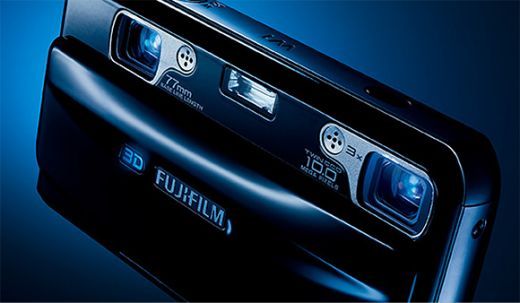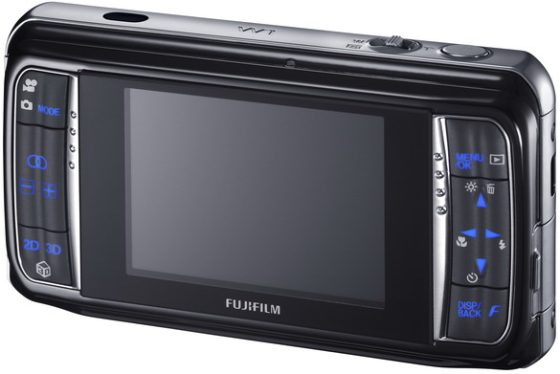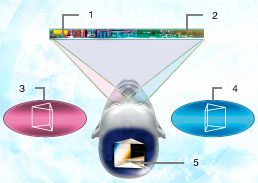The future of photography? Fujifilm 3D digital camera
 Fujifilm launched their new imaging technology called FinePix Real 3D System. It is the World’s first 3D digital imaging system that lets you enjoy three dimensional images without the need to wear special 3D glasses. The Real 3D W1 camera features the newly developed Real 3D Lens System. To achieve a natural, 3D image, it was necessary to flawlessly layer together two images, so two Fujinon lenses, renowned for their high resolution and exquisite rendering, were installed. A robust aluminum die-cast frame has been used to protect the lenses from vibration and impact.
Fujifilm launched their new imaging technology called FinePix Real 3D System. It is the World’s first 3D digital imaging system that lets you enjoy three dimensional images without the need to wear special 3D glasses. The Real 3D W1 camera features the newly developed Real 3D Lens System. To achieve a natural, 3D image, it was necessary to flawlessly layer together two images, so two Fujinon lenses, renowned for their high resolution and exquisite rendering, were installed. A robust aluminum die-cast frame has been used to protect the lenses from vibration and impact.
A 3x optical zoom, deemed difficult to achieve in 3D photography because of the precision required to align two lenses, is also possible. Moreover, the RP (Real Photo) Processor 3D which is based on photo technology that Fujifilm has developed over the years, synchronizes data passed to it by the two lenses and two CCD sensors, to determine shooting conditions such as focus, brightness and tonality to instantaneously blend this information into a single symmetrical image, for both stills and movies.
The Real 3D camera allows you to adjust the settings to suit the scene being photographed. When using the 3D two-shot function, the camera shifts to take the second shot after taking the first shot, and saves a single 3D image in the camera manually. This allows you to edit the 3D images, particularly useful for long zoom telephoto shots where a 3D image is difficult to achieve, or conversely, macro shots, where the 3D effect can be too strong.
3D Interval Shooting allows further flexibility; it is possible to take two shots from different viewpoints continuously while the photographer is moving, for example by train, airplane, or car, etc., to achieve 3D images of long-distance views. Users can enjoy more dynamic 3D shots, whether they are capturing a sea of clouds from an airplane, or taking 3D shots of distant views from a car window. By using the Parallax Control function, the 3D images can be manually adjusted, either during filming or while viewing the images on the LCD monitor.
In 2D mode it has performance as most of today’s digital cameras. The 10 megapixel Fujifilm Finepix Real 3D W1 very much falls into the point and shoot category of cameras. It has a 3x optical zoom, ISO sensitivity up to 1600 whilst, in terms of metering the Finepix Real 3D W1 has a total of 256-zones with spot, multi and average offered as metering selections.
There are some additional options which are available due to the fact the camera has 2 lenses. Advanced 2D Mode uses Dual Capture simultaneous shooting which lets users take two different shots simultaneously by pressing the shutter once. Tele+Wide Shooting enables you to take a close-up photo of the subject and, at the same time, a photo with a wider span – just by changing the settings of the two lenses. With Color Mode Dual Shooting users can take photos of the same scene with different color tonalities.
We found Sensitivity Mode Dual Shooting mode most useful because it enables you to change the sensitivity setting of the two shooting systems, which expands the range of photographic expression. In scenes where it is difficult to determine the optimal camera settings, users can take shots with image stabilization priority and then with picture quality priority and choose the best image later, or in panned shots, change the image stabilization levels to take two different shots simultaneously.
The exterior finish is a luxurious Piano Black with a superb, high-gloss, elegant shine. To add to the glamour, the neon blue “3D” logo illuminates when the camera is switched on. On the back of the camera, operating buttons (such as the one-touch 3D/2D switch button) are placed on both sides of the camera for simple operation using both hands. The newly developed 2.8-inch Real 3D LCD monitor displays natural and beautiful 2D and 3D images, enabling you to compose and playback your pictures easily.
The 3D LCD monitor relies on our ability to perceive depth from viewing an object along two different lines of sight. This phenomenon is called parallax. The monitor on the 3D digital camera uses an originally developed Light Direction Control System, and the 3D digital viewer adopts a Parallax Barrier System to precisely direct light to the right and left eyes in a way that simulates parallax. Both enable easy and natural viewing of 3D images with just the naked eye.
And last but not least – the drawbacks. Since it’s a new product which needs to be accepted in the market you would expect it to be cheaper and more accessible. However the price for the camera itself, as well as the additional equipment is pretty high. The 3D LCD display, although easing the usage of the camera, isn’t built as well as some of the other models of 3D LCD displays. When you view it you need to tilt the device just right in order to see the 3D effect and the image often flickers even when you get the angle right (and that’s really annoying when you use it often).
Overall, it is an interesting device which offers many new ways to experiment with your photographs. However, due to its price it isn’t too accessible to everyday photography enthusiasts. We hope the problems with the viewer are going to be fixed in some of the next series because this is the potential future of photography.












Leave your response!